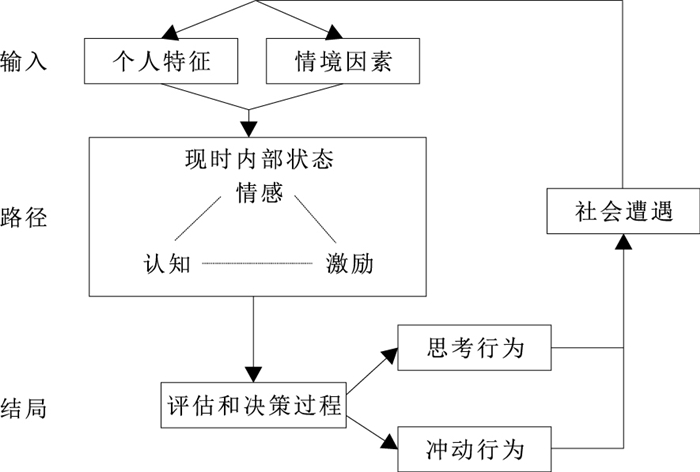Research progress of adolescent cyberbullying
-
摘要: 青少年网络欺凌是在电子社交网络环境下,通过电子手段对青少年实施的攻击性暴力行为,且由于网络的匿名性和传播的快速性,对青少年身心产生严重而深远的影响。随着信息技术的发展,网络欺凌方式层出不穷,网络欺凌的影响因素和形成机制多样复杂。本文从流行特征、影响因素、相关理论模型等角度系统阐述了青少年网络欺凌的研究进展,以期能为家庭、学校、社会构建预防青少年网络欺凌的公共卫生体系提供借鉴。Abstract: Adolescent cyberbullying refers to adolescents who are subjected to offensive and violent behavior in social network environments through electronic technologies. Due to the anonymity of the Internet and the rapidity of transmission, cyberbullying has a serious and far-reaching impact on the physical and mental health of teenagers. With the development of information technology, various forms of cyberbullying have emerged, and the formation mechanism and influencing factors of cyberbullying are diverse and complex. This article systematically reviews the research progress in cyberbullying by evaluating the epidemic characteristics, influencing factors, and related theoretical models that are relevant to adolescents, so as to provide a referential framework to build a public health system that can prevent cyberbullying in families, schools, and society.
-
Key words:
- Internet /
- Violence /
- Mental health /
- Adolescent /
- Students
-
表 1 网络欺凌与传统欺凌的区别
Table 1. Difference between cyberbulling and bulling
欺凌类别 存在场域 作用形式 发生地 施暴者 匿名性 传播性 主要危险 影响程度 传统欺凌 现实社会 直接接触 校园或其他公共场所 可见 无 较局限 躯体、心理伤害 直接破坏性 网络欺凌 现实社会和虚拟网络社会 间接(通过电脑或手机) 无限制 未知 有 迅速而广泛 心理伤害 广泛持久性 -
[1] OLWEUS D. School bullying: development and some important challenges[J]. Ann Rev Clin Psychol, 2013, 9(1): 751-780. doi: 10.1146/annurev-clinpsy-050212-185516 [2] 郑茹, 星一, 段佳丽. 青少年网络欺凌行为流行及干预现状[J]. 中国学校卫生, 2017, 38(6): 955-959. doi: 10.16835/j.cnki.1000-9817.2017.06.052ZHENG R, XING Y, DUAN J L. Prevalence and intervention of cyberbullying among adolescents[J]. Chin J Sch Health, 2017, 38(6): 955-959. doi: 10.16835/j.cnki.1000-9817.2017.06.052 [3] ORTEGA R, ELIPE P, MORA-MERCHAN J A, et al. The emotional impact of bullying and cyberbullying on victims: a European cross-national study[J]. Aggress Behav, 2012, 38(5): 342-356. doi: 10.1002/ab.21440 [4] HOGAN M, STRASBURGER V. Twenty questions(and answers) about media violence and cyberbullying[J]. Pediatr Clin North Am, 2020, 67(2): 275-291. doi: 10.1016/j.pcl.2019.12.002 [5] KESSEL SCHNEIDER S, O'DONNELL L, SMITH E. Trends in cyberbullying and school bullying victimization in a regional census of high school students, 2006-2012[J]. J Sch Health, 2015, 85(9): 611-620. doi: 10.1111/josh.12290 [6] CHANG F C, LEE C M, CHIU C H, et al. Relationships among cyberbullying, school bullying, and mental health in Taiwanese adolescents[J]. J Sch Health, 2013, 83(6): 454-462. doi: 10.1111/josh.12050 [7] SCHNEIDER S K, O'DONNELL L, STUEVE A, et al. Cyberbullying, school bullying, and psychological distress: a regional census of high school students[J]. Am J Public Health, 2012, 102(1): 171-177. doi: 10.2105/AJPH.2011.300308 [8] SUZUKI K, ASAGA R, SOURANDER A, et al. Cyberbullying and adolescent mental health[J]. Int J Adolesc Med Health, 2012, 24(1): 27-35. http://europepmc.org/abstract/MED/22909909 [9] 欧阳叶. 旁观者效应对青少年网络欺凌的影响[J]. 中国学校卫生, 2019, 40(12): 1916-1920. doi: 10.16835/j.cnki.1000-9817.2019.12.044OUYANG Y. The influence of bystander effect on cyberbullying among adolescents[J]. Chin J Sch Health, 2019, 40(12): 1916-1920. doi: 10.16835/j.cnki.1000-9817.2019.12.044 [10] MODECKI K L, MINCHIN J, HARBAUGH A G, et al. Bullying prevalence across contexts: a Meta-analysis measuring cyber and traditional bullying[J]. J Adolesc Health, 2014, 55(5): 602-611. doi: 10.1016/j.jadohealth.2014.06.007 [11] ABOUJAOUDE E, SAVAGE M W, STARCEVIC V, et al. Cyberbullying: review of an old problem gone viral[J]. J Adolesc Health, 2015, 57(1): 10-18. doi: 10.1016/j.jadohealth.2015.04.011 [12] ANDERSON M. A majority of teens have experienced some form of cyberbullying. Washington DC: Pew Research Center, 2018. [13] 刘丽琼, 彭茹静. 初中生网络欺负行为的普遍性及其影响[J]. 教育测量与评价, 2014(3): 42-45. doi: 10.3969/j.issn.1674-1536.2014.03.012LIU L Q, PENG R J. The prevalence and influence of cyberbullying among middle school students[J]. Educ Meas Evalut, 2014(3): 42-45. doi: 10.3969/j.issn.1674-1536.2014.03.012 [14] 朱银潮, 李辉, 龚清海, 等. 宁波市中学生暴力行为流行现状及影响因素分析[J]. 中国学校卫生, 2017, 38(9): 1362-1365. doi: 10.16835/j.cnki.1000-9817.2017.09.024ZHU Y C, LI H, GONG Q H, et al. The prevalence and influence factors analysis of violence behavior among middle and high school students in Ningbo[J]. Chin J Sch Health, 2017, 38(9): 1362-1365. doi: 10.16835/j.cnki.1000-9817.2017.09.024 [15] USA Centers for Disease Control and prevention. Youth risk behavior survey(2013). (2014-01-30). http://www.cdc.gov/yrbs. [16] MESSIAS E, KINDRICK K, CASTRO J. School bullying, cyberbullying, or both: correlates of teen suicidality in the 2011 CDC youth risk behavior survey[J]. Compr Psychiatry, 2014, 55(5): 1063-1068. doi: 10.1016/j.comppsych.2014.02.005 [17] SMITH P K, SLONJA R. Cyberbullying: the nature and extent of a new kind of bullying, in and out of school[M]. New York: Routledge, 2010: 249-262. [18] MUELLER A S, JAMES W, ABRUTYN S, et al. Suicide ideation and bullying among US adolescents: examining the intersections of sexual orientation, gender, and race/ethnicity[J]. Am J Public Health, 2015, 105(5): 980-985. doi: 10.2105/AJPH.2014.302391 [19] PETERSON M B, PETERSON K A. Cyberbullying and race: s literature review[J]. Int J Learn Divers Ident, 2014, 20(2): 17-28. doi: 10.18848/2327-0128/CGP/v20i02/48563 [20] BROCHADO S, SOARES S, FRAGA S. A scoping review on studies of cyberbullying prevalence among adolescents[J]. Traum Viol Abuse, 2016, 18(5): 523-531. http://repositorio-aberto.up.pt/bitstream/10216/111522/1/Brochado185.pdf [21] WEST D. An investigation into the prevalence of cyberbullying among students aged 16-19 in post-compulsory education[J]. Res Post-Compuls Educ, 2015, 20(1): 96-112. doi: 10.1080/13596748.2015.993879 [22] ZYCH I, BALDRY A C, FARRINGTON D P, et al. Are children involved in cyberbullying low on empathy? a systematic review and Meta-analysis of research on empathy versus different cyberbullying roles[J]. Aggress Viol Behav, 2019, 45: 83-97. doi: 10.1016/j.avb.2018.03.004 [23] LOMAS J, STOUGH C, HANSEN K, et al. Brief report: emotional intelligence, victimization and bullying in adolescents[J]. J Adolesc, 2012, 35(1): 207-211. doi: 10.1016/j.adolescence.2011.03.002 [24] CHOI B, PARK S. Who becomes a bullying perpetrator after the experience of bullying victimization? the moderating role of self-esteem[J]. J Youth Adolesc, 2018, 47(11): 2414-2423. doi: 10.1007/s10964-018-0913-7 [25] SOURANDER A, KLOMEK A B, IKONEN M, et al. Psychosocial risk factors associated with cyberbullying among adolescents: a population-based study[J]. Arch Gen Psychiatry, 2010, 67(7): 720-728. doi: 10.1001/archgenpsychiatry.2010.79 [26] 汪耿夫, 方玉, 江流, 等. 安徽省中学生网络欺凌与自杀相关心理行为的关联研究[J]. 卫生研究, 2015, 44(6): 896-903. https://www.cnki.com.cn/Article/CJFDTOTAL-WSYJ201506005.htmWANG G F, FANG Y, JIANG L, et al. Relationship between cyberbullying and the suicide realted psychological behavior among middle and high school students in Anhui Province[J]. J Hyg Res, 2015, 44(6): 896-903. https://www.cnki.com.cn/Article/CJFDTOTAL-WSYJ201506005.htm [27] 沈跃龙. 大学生网络暴力问题的心理研究[J]. 法制与社会, 2016(16): 234-235. https://www.cnki.com.cn/Article/CJFDTOTAL-FZSL201616111.htmSHEN Y L. Psychological research of cyberbullying among college students[J]. Legal System Soc, 2016(16): 234-235. https://www.cnki.com.cn/Article/CJFDTOTAL-FZSL201616111.htm [28] MODECKI K L, BARBER B L, VERNON L. Mapping developmental precursors of cyber-aggression: trajectories of risk predict perpetration and victimization[J]. J Youth Adolesc, 2013, 42(5): 651-661. doi: 10.1007/s10964-012-9887-z [29] HOLFELD B, LEADBEATER B J. The nature and frequency of cyber bullying behaviors and victimization experiences in young Canadian children[J]. Can J Sch Psychol, 2015, 30(2): 21-40. http://www.onacademic.com/detail/journal_1000036967765610_9f71.html [30] MASCHERONI G, óLAFSSON K. The mobile Internet: access, use, opportunities and divides among European children[J]. New Med Soc, 2015: 1657-1679. http://www.onacademic.com/detail/journal_1000037346514510_7da1.html [31] ENGLANDER E K. Risky business: talking with your patients about cyberbullying and sexting[J]. Child Adolesc Psychiatr Clin N Am, 2018, 27(2): 287-305. doi: 10.1016/j.chc.2017.11.010 [32] PRESCOTT A T, SARGENT J D, HULL J G. Meta-analysis of the relationship between violent video game play and physical aggression over time[J]. Proc Natl Acad Sci USA, 2018, 115(40): 9882-9888. doi: 10.1073/pnas.1611617114 [33] MEHARI K R, FARELL A D, LE A T H. Cyberbullying among adolescents: measures in search of a construct[J]. Psychol Viol, 2014, 4(4): 399-415. doi: 10.1037/a0037521 [34] WEBER M, ZIEGELE M, SCHNAUBER A. Blaming the victim: the effects of extraversion and information disclosure on guilt attributions in cyberbullying[J]. Cyberpsychol Behav Soc Netw, 2013, 16(4): 254-259. doi: 10.1089/cyber.2012.0328 [35] MCLOUGLIN L, SPEARS B, TADDEO C. The importance of social connection for cybervictims: how connectedness and technology could promote mental health and wellbeing in young people[J]. Int J Emot Educ, 2018, 10(1): 5-24. [36] MARTINEZ-MONTEAGUDO M C, DELGADO B, INGLES C J, et al. Cyberbullying in the university setting. relationship with family environment and emotional intelligence[J]. Comput Hum Behav, 2019, 91(1): 220-225. http://www.sciencedirect.com/science/article/pii/S0747563218304850 [37] ALQAHTANI S, ELBEDOUR S, FREEMAN K, et al. Cyberbullying in colleges and universities: a survey of student experiences and attitudes about cyberbullying[J]. Int J Child Adolesc Health, 2018, 11(1): 73. http://www.questia.com/library/journal/1P4-2102830582/cyberbullying-in-colleges-and-universities-a-survey [38] CASSIDY W, FAUCHER C, JACKSON M. Adversity in university: cyberbullying and its impacts on students, faculty and administrators[J]. Int J Environ Res Public Health, 2017, 14(8): 888-907. doi: 10.3390/ijerph14080888 [39] MOON B, HWANG H, MCCLUSKEY J D. Causes of school bullying: empirical test of general theory of crime, differential association, general strain theory[J]. Crime Delinq, 2011, 6(57): 849-877. http://www.onacademic.com/detail/journal_1000035557278610_9891.html [40] AGNEW R. Foundation for a general strain theory of crime and delinquency[J]. Criminology, 1992, 30(1): 47-88. doi: 10.1111/j.1745-9125.1992.tb01093.x [41] HINDUJA S, PATCHIN J W. Social influences on cyberbullying behaviors among middle and high school students[J]. J Youth Adolesc, 2013, 42(5): 711-722. doi: 10.1007/s10964-012-9902-4 [42] PAEZ G R. Cyberbullying among adolescents: a general strain theory prspective[J]. J Sch Viol, 2018, 17(1): 74-85. doi: 10.1080/15388220.2016.1220317 [43] ANDERSON C A, BUSHMAN B J. Human aggression[J]. Ann Rev Psychol, 2003, 53(19): 27-51. [44] COWIE H, NAYLOR P, RIVERS I, et al. Measuring workplace bullying[J]. Aggress Viol Behav, 2002, 7(1): 33-51. doi: 10.1016/S1359-1789(00)00034-3 [45] ANDERSON C A, SUZUKI K, SWING E L, et al. Media violence and other aggression risk factors in seven nations[J]. Pers Soc Psychol Bull, 2017, 43(7): 986-998. doi: 10.1177/0146167217703064 [46] TENG Z, NIE Q, GUO C, et al. A longitudinal study of link between exposure to violent video games and aggression in Chinese adolescents: the mediating role of moral disengagement[J]. Dev Psychol, 2019, 55(1): 184-195. doi: 10.1037/dev0000624 [47] ROBINSON M D. Running from William James' bear: a review of preattentive mechanisms and their contributions to emotional experience[J]. Cogn Emot, 1998, 12(5): 667-696. doi: 10.1080/026999398379493 [48] BARLETT C P. Predicting adolescent's cyberbullying behavior: a longitudinal risk analysis[J]. J Adolesc, 2015, 41: 86-95. doi: 10.1016/j.adolescence.2015.02.006 [49] BARLETT C P, GENTILE D A, CHEW C. Predicting cyberbullying from anonymity[J]. Psychol Popular Med Cult, 2016, 5(2): 171-180. doi: 10.1037/ppm0000055 [50] BARLETT C, CHAMBERLIN K, WITKOWER Z. Predicting cyberbullying perpetration in emerging adults: atheoretical test of the barlett gentile cyberbullying model[J]. Aggress Behav, 2017, 43(2): 147-154. doi: 10.1002/ab.21670 [51] AJZEN I. The theory of planned behavior[J]. Organ Behav Hum Dec, 1991, 50: 179-211. doi: 10.1016/0749-5978(91)90020-T [52] FESTL R, SCHARKOW M, QUANDT T. Peer influence, internet use and cyberbullying: a comparison of different context effects among German adolescents[J]. J Chil Media, 2013, 7(4): 1-17. http://www.onacademic.com/detail/journal_1000035855210610_6547.html [53] HINDUJA S, PATCHIN J W. Social influences on cyberbullying behaviors among middle and high school students[J]. J Youth Adolesc, 2013, 42(5): 711-722. doi: 10.1007/s10964-012-9902-4 [54] LAW D M, SHAPKA J D, DOMENE J F, et al. Are cyberbullies really bullies? an investigation of reactive and proactive online aggression[J]. Comput Hum Behav, 2012, 28(2): 664-672. doi: 10.1016/j.chb.2011.11.013 [55] HEIRMAN W, WALRAVE M. Predicting adolescent perpetration in cyberbullying: an application of the theory of planned behavior[J]. Psicothema, 2012, 24(4): 614-620. http://www.researchgate.net/profile/Wannes_Heirman2/publication/232319834_Predicting_adolescent_perpetration_in_cyberbullying_An_application_of_the_theory_of_planned_behavior/links/55ddcff708ae7983897d0795.pdf [56] PABIAN S, VANDEBOSCH H. Using the theory of planned behaviour to understand cyberbullying: the importance of beliefs for developing interventions[J]. Eur J Dev Psychol, 2013, 11(4): 463-477. doi: 10.1080/17405629.2013.858626 [57] FINNE J, ROLAND E, SVARTDAL F. Relational rehabilitation: reducing the harmful effects of bullying[J]. Nord Stud Educ, 2018, 38(4): 352-367. doi: 10.18261/issn.1891-2018-04-05 [58] 毛向樱, 康书豪. 自媒体网络暴力的传播形态及应对策略[J]. 新闻战线, 2018(2): 22-23. https://www.cnki.com.cn/Article/CJFDTOTAL-XWZX201802010.htmMAO X Y, KANG S H. The spreading forms and coping strategies of we media cyberbullying[J]. Press, 2018(2): 22-23. https://www.cnki.com.cn/Article/CJFDTOTAL-XWZX201802010.htm -







 下载:
下载:


